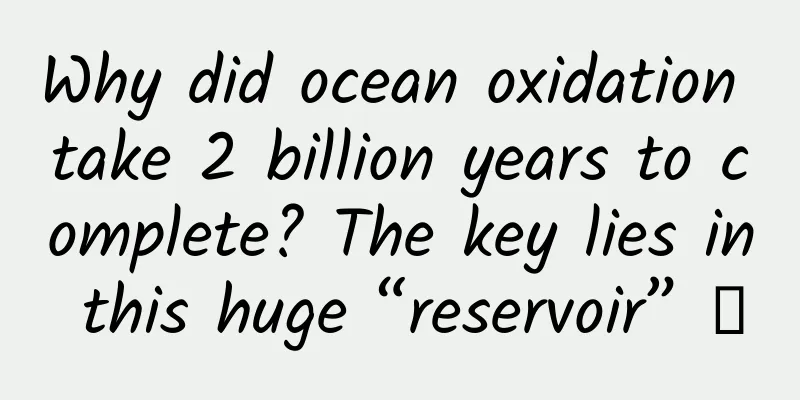Why did ocean oxidation take 2 billion years to complete? The key lies in this huge “reservoir” →

|
Oxygen is the source of life. The oxygen content on the early Earth was extremely low until 2.4 billion years ago, when the first great oxidation event occurred on Earth, when the oxygen content reached more than 1% of today's level, leading to the first appearance of eukaryotic organisms on Earth. The second great oxidation event occurred between 580 million and 520 million years ago, when the oxygen content in the atmosphere increased to more than 60% of the modern atmospheric oxygen content, triggering the rapid origin of animals and the Cambrian explosion. Why did the oxidation of the Earth's atmosphere and oceans take nearly 2 billion years to increase dramatically after the first Great Oxidation Event? A Sino-British collaborative team led by Zhu Maoyan, a researcher at the Nanjing Institute of Geology and Paleontology, Chinese Academy of Sciences, used a variety of geochemical indicators and combined with mathematical models to systematically demonstrate for the first time that the existence of a huge ocean dissolved organic carbon reservoir was the key reason for the delay in the complete oxidation of the Proterozoic ocean. The results were recently published in the earth science journal Earth and Planetary Science Letters. The dissolved organic carbon pool model was first proposed by American scholars. The model believes that the microorganisms that perform photosynthesis in the surface translucent zone of the Precambrian ocean are mainly prokaryotes. The organic matter particles of these microorganisms after death are small and the sedimentation rate is slow. They continue to accumulate in the seawater to form a huge marine dissolved organic carbon pool, which is more than 1,000 times the dissolved organic carbon pool in the modern ocean. Because these small organic matter particles, mainly bacteria, are easily oxidized and degraded, they consume a large amount of oxygen in seawater, resulting in long-term hypoxia in the ocean and preventing the increase of atmospheric oxidation. This is like the Precambrian ocean is a huge swamp pool, and a large amount of humus organic matter in the water body constantly consumes oxygen, causing the water body to be turbid and hypoxic. Only when this organic carbon pool is completely removed can the oxygen content in the atmosphere and the ocean be substantially increased. However, this model was subsequently questioned, and opponents believed that the ancient earth could not provide enough oxidants to remove the huge carbon pool in the ocean. In 2019, Zhu Maoyan led a Chinese and British team to publish an article in Nature Geoscience, proposing that large-scale mountain building movements lead to the weathering of huge amounts of evaporite minerals formed in sea basins, which can bring about a large amount of sulfate (oxidant). These sulfate-reducing bacteria consume the dissolved organic carbon in seawater on a large scale, and through the large-scale burial of pyrite (oxygen production), ultimately lead to a reduction in the carbon pool and rapid oxidation of the ocean. To support this hypothesis, the team discovered the largest but short-lived carbon isotope negative drift event in geological history in the Ediacaran Doushantuo Formation (about 600 million years ago) at the Nantuo Village section in the Three Gorges region of my country. In order to understand the cause of this negative drift event, the team conducted a detailed analysis of multiple isotope systems such as carbon, oxygen, sulfur, uranium, and strontium, and ultimately revealed that this was a short-lived marine oxidation event triggered by increased sulfuric acid input caused by enhanced continental weathering. They analyzed that the negative carbon isotope drift event in the early Ediacaran period may mark the beginning of the disintegration of this large deep-sea dissolved organic carbon pool. Subsequent pulsed oxidant input events of longer duration and greater intensity continuously consumed the dissolved organic carbon pool in the ocean, causing it to eventually die out in the early Cambrian period. The ocean became more oxidized, creating the prerequisites for the explosion of animals in the early Cambrian period and the emergence of complex marine ecosystems. |
>>: To protect the environment, they put backpacks on cows to collect farts
Recommend
Grab the last drop of customer acquisition bonus, these 7 methods can help you
In early March of this year, Wang Xing mentioned ...
Tips for creating short video scripts
A script is the outline needed for shooting a sho...
Is it the season for rashes again? Don’t worry, take a look at Feng Shui first
My child has a high fever and a rash? Rubella, me...
Ma Huateng's "prediction" has come true? Scanning code payment will become a thing of the past, and WeChat is also "threatened"
Around 2015, Ma Huateng expressed his concerns ab...
How to show your "scientific literacy" when others are playing in the snow? | Expo Daily
How to watch others play in the snow Demonstrate ...
In-depth analysis of Pinduoduo’s product operations in 2019!
Jobs said that consumers don’t know what they nee...
Does spending money to buy happiness really work?
It’s the Double Eleven shopping season again. Hav...
Breakthrough Academy Online Course Monetization Training Camp: Turn knowledge/experience/skills into money in 10 days
Breakout Academy Online Course Monetization Train...
Black hat SEO teaching video: Black hat SEO technical practical training video free online download!
When we are doing website SEO optimization, we al...
Analysis of 4 factors of Keep user experience!
A week ago, QuestMobile released the "China ...
Huang Zhiyi: A climber who rushes to the highest "rock point" of the "dangerous peak" of algorithms!
Even on days when he is not climbing, Huang Zhiyi...
Daokun "Taobao Blue Ocean Profitable Non-standard Product Selection Ideas" Daokun Taobao Internal Training Club [2021], worth 4980 yuan Baidu Cloud Download
Dao Kun Taobao Blue Ocean Internal Training is a ...
You can recognize everything by taking a photo. How does AI “understand” pictures?
Welcome to Science Popularization China’s special...
Following WeChat, QQ and 59 other apps: Google and Apple's Indian app stores will remove Baidu and Weibo
According to the Times of India, the Indian gover...
Alibaba Mini Program Customization Company, how much does it cost to customize a hotel mini program?
What is the price for customizing the Ali Hotel m...









